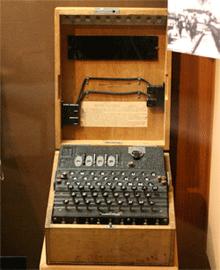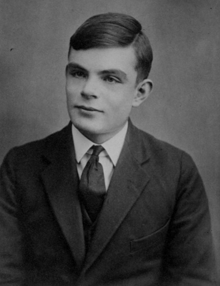|
Enigma Machine used by the German military
Answer
to Name
This Famous Antique Game - September 2015
By Mike McLeod

History buffs, students of World War II and fans of the movie The Imitation Game are familiar with the Enigma machine used by the German military forces for encoding messages. Other movies about the Enigma machine were U-571 and Enigma.
Some history buffs will know a German engineer invented the first model of the Enigma after the First World War. The Polish intelligence service was able to break the code of this early model in 1932. It was updated over the years, going from having three rotors (or drums) with 26 letters on each to up to eight rotors with 26 to 29 letters.
To encode a message, the rotors were moved mechanically by typing on keys. Then, to add another level of complexity, they were also moved electrically; electrical contacts on each side of the rotor also changed the letter typed. But this wasn’t all. Later versions of the Enigma were constructed with a plug board on the front, similar to that of an old telephone operator board where cables were plugged in to connect calls. The Enigma’s plug board cables only wired two letters together at a time, but several pairs could be connected to change the starting letter of the message and add another level of complexity to the encryption.
In addition to these difficult encryption techniques, the Germans provided the senders and receivers with a codebook and changed the starting codes every day. This was one of the main reasons why the Enigma was so hard to crack—later models could create 159 quintillion (159 million million) different code combinations. This made it impossible to crack by hand. Fortunately, the Allies had a head start on cracking the Enigma’s codes when the Polish intelligence service turned over their information in 1939 and the early models of the Enigma they made.
Even so, it was a near impossible task to solve the Enigma, and it required the genius efforts of several people, most notably Alan Turing, who was lauded in the movie, The Imitation Game. The British team of code crackers working at Bletchley Park outside London was led by Dilly Knox and included John Jeffers, Peter Twinn and Joan Clarke. Mathematician Gordon Welchman also collaborated on the construction of the Enigma-cracking machine, which they called the “Bombe,” or “bomb.” This was derived from the name the Polish intelligence gave their machine, the “cryptologic bomb.” Turing’s machine was not called “Christopher” as portrayed in The Imitation Game.
Various models of the Enigma were used by the German Army, Navy and Luftwaffe Air Force. The Bletchley Park team cracked all of them, including models that were updated during the war. It has been said that this team’s work shortened the war in Europe by two to four years. Its efforts were so secret and of such importance to national security that they were not revealed until the 1970s.
The movie U-571 starring Matthew McConaughey was actually misleading. It depicted an American submarine crew capturing an Enigma from a German submarine. In fact, it was a British crew. In all, 15 Enigmas were captured during the war: 13 by the British, one by the Canadians and one by the Americans.
An Enigma I (a later model from 1943) was sold in July 2015 by Sotheby’s in London for $232,000 including buyer’s premium. It was estimated at $50,000-$70,000. Alan Turing’s journal from 1942-1944, during the time he worked on the Enigma, sold for $1,025,000 at Bonham’s in April 2015. It focused mostly on foundations of computer science, which was cutting-edge, sci-fi technology at the time. Turing wrote many papers, including some on artificial intelligence.
Julie Kimbrell of The Old School Antique Mall in Sylva, N.C., Jeff Leibowitz of York, S.C., Ted Carlton of Utah, and Dr. Scott and Carolyn Brown of Montgomery, Ala., correctly identified the Enigma machine.
------------------------------
Sources:
Bletchley Park, Bletchleypark.org.uk.
Bonhams.com.
Christies.com.
Historyvshollywood.com/reelfaces/imitation-game.
Wikipedia.org.
|

A four-rotor Enigma machine used by the Germany Navy. (Photo, courtesy of RadioFan.)

Alan Turing at age 16.

A replica of the Bombe that cracked the Enigma’s codes. (Photo, courtesy of TomYates.)
|